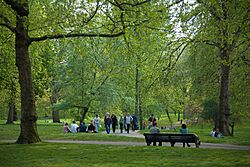Green Park facts for kids
Quick facts for kids Green Park |
|
|---|---|
 |
|
| Lua error in Module:Location_map at line 420: attempt to index field 'wikibase' (a nil value). | |
| Type | Public park |
| Location | London, SW1 United Kingdom |
| Area | 19 hectares (47 acres) |
| Operated by | The Royal Parks |
| Public transit access | |
The Green Park is one of the eight Royal Parks of London. It's located in the City of Westminster, right in the heart of Central London. If you stand in Green Park, you'll find Buckingham Palace just across Constitution Hill road.
This park is special because it's part of a long chain of green spaces in Westminster. These include St James's Park, Hyde Park, and Kensington Gardens. It's like a giant green ribbon running through the city!
King Charles II first made Green Park an official park in the 1600s. It was later designed more carefully in 1820. Unlike other big London parks, Green Park doesn't have any lakes or large buildings. It also has very few planted flowers, mostly just pretty daffodils that grow naturally.
Contents
Exploring Green Park
Green Park covers about 40 acres (16 ha) of land. It sits between Hyde Park and St. James's Park. When you add Kensington Gardens and the gardens of Buckingham Palace, these parks create a huge, beautiful green area. It's a perfect place for a walk or to relax.
What Makes Green Park Special?
Green Park is different from its nearby parks. It doesn't have any lakes, buildings, or playgrounds. Instead, it has three important public monuments from after World War II:
- The Canada Memorial is a tribute to Canadian soldiers.
- The Diana of the Treetops Fountain is near the Green Park tube station.
- The RAF Bomber Command Memorial honors the brave airmen of World War II.
The park is mostly made up of tall, old trees growing from grassy areas. The only flowers you'll usually see are the lovely daffodils that pop up in spring.
Where is Green Park?
The park has Constitution Hill to its south. To the east, you'll find the Queen's Walk, a path just for people walking. Piccadilly road is to the north. Green Park meets St. James's Park at Queen's Gardens. The famous Victoria Memorial is right there, across from the entrance to Buckingham Palace.
The Green Park Underground station is very handy. It serves the Piccadilly, Victoria, and Jubilee train lines. It's located near the north end of Queen's Walk. Did you know that the Tyburn stream actually flows underneath Green Park?
In 2016, a small part of the park became a special wildflower meadow. It's called The Queen's Meadow. Seeds from old meadows were used to create it. Now, you can see many different flowers there, like yellow rattle and common poppy.
A Look Back: Green Park's History
For many years in medieval times, this area was a swampy burial ground. It was used for people with leprosy from a nearby hospital. In the 1500s, it became part of the Poulteney family's land. People even dug up sand here to use for building materials.
Becoming a Royal Park
In 1668, this "Sandpit Field" was given to King Charles II. He turned most of the land into a Royal Park. He called it "Upper St James's Park" and built a brick wall around it. The King also created its main paths and built an icehouse. This icehouse helped keep drinks cool for the royal family in summer.
In 1746, "Upper St. James's Park" was officially renamed The Green Park. At that time, it was an open field with very few flowers. There's a fun story about why there aren't many flowers. It's said that King Charles II picked flowers in the park for another woman. His wife, Catherine of Braganza, found out. As revenge, she ordered that every single flower in the park be pulled up! And no more were planted after that.
Changes Over Time
The Queen's Walk was created for King George II's wife, Queen Caroline. This path led to a reservoir that held drinking water for St James's Palace.
For a long time, the park was on the edge of London. It was quite dark and felt like the countryside. It was even known as a place where highwaymen (robbers) and thieves would hide. In the 1700s and 1800s, Green Park was a popular spot for hot air balloon flights and public fireworks shows. The famous composer Handel even wrote his Music for the Royal Fireworks for a fireworks display held in Green Park in 1749!
The park was also a place where people would have duels. A famous duel happened in 1730 between William Pulteney, 1st Earl of Bath and John Hervey, 1st Earl of Bristol.
In 1820, John Nash redesigned the park. He made it an extension of St James's Park. On June 10, 1840, something important happened here. Edward Oxford tried to assassinate Queen Victoria on Constitution Hill. Luckily, she was unharmed.
Images for kids
-
Green Park and Constitution Hill
-
Pierre Granche's Canada Memorial in Green Park, London, near Buckingham Palace
-
Green Park and St. James's Park c.1833
-
Buckingham Palace, as seen from Green Park







